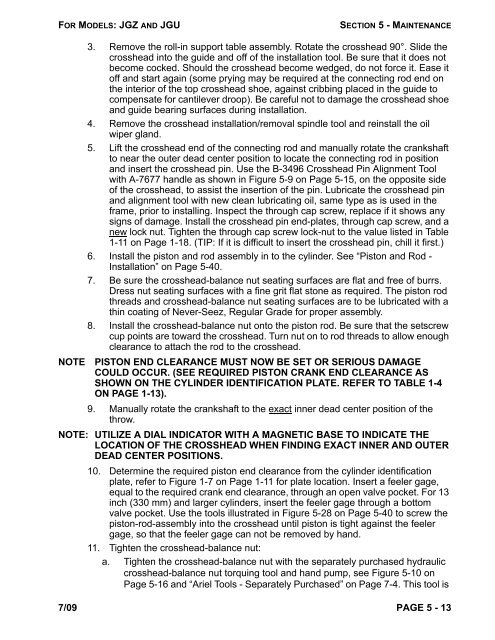Heavy Duty Balanced Opposed Compressors - Ariel Corporation
Heavy Duty Balanced Opposed Compressors - Ariel Corporation
Heavy Duty Balanced Opposed Compressors - Ariel Corporation
Create successful ePaper yourself
Turn your PDF publications into a flip-book with our unique Google optimized e-Paper software.
FOR MODELS: JGZ AND JGU SECTION 5 - MAINTENANCE<br />
3. Remove the roll-in support table assembly. Rotate the crosshead 90°. Slide the<br />
crosshead into the guide and off of the installation tool. Be sure that it does not<br />
become cocked. Should the crosshead become wedged, do not force it. Ease it<br />
off and start again (some prying may be required at the connecting rod end on<br />
the interior of the top crosshead shoe, against cribbing placed in the guide to<br />
compensate for cantilever droop). Be careful not to damage the crosshead shoe<br />
and guide bearing surfaces during installation.<br />
4. Remove the crosshead installation/removal spindle tool and reinstall the oil<br />
wiper gland.<br />
5. Lift the crosshead end of the connecting rod and manually rotate the crankshaft<br />
to near the outer dead center position to locate the connecting rod in position<br />
and insert the crosshead pin. Use the B-3496 Crosshead Pin Alignment Tool<br />
with A-7677 handle as shown in Figure 5-9 on Page 5-15, on the opposite side<br />
of the crosshead, to assist the insertion of the pin. Lubricate the crosshead pin<br />
and alignment tool with new clean lubricating oil, same type as is used in the<br />
frame, prior to installing. Inspect the through cap screw, replace if it shows any<br />
signs of damage. Install the crosshead pin end-plates, through cap screw, and a<br />
new lock nut. Tighten the through cap screw lock-nut to the value listed in Table<br />
1-11 on Page 1-18. (TIP: If it is difficult to insert the crosshead pin, chill it first.)<br />
6. Install the piston and rod assembly in to the cylinder. See “Piston and Rod -<br />
Installation” on Page 5-40.<br />
7. Be sure the crosshead-balance nut seating surfaces are flat and free of burrs.<br />
Dress nut seating surfaces with a fine grit flat stone as required. The piston rod<br />
threads and crosshead-balance nut seating surfaces are to be lubricated with a<br />
thin coating of Never-Seez, Regular Grade for proper assembly.<br />
8. Install the crosshead-balance nut onto the piston rod. Be sure that the setscrew<br />
cup points are toward the crosshead. Turn nut on to rod threads to allow enough<br />
clearance to attach the rod to the crosshead.<br />
NOTE PISTON END CLEARANCE MUST NOW BE SET OR SERIOUS DAMAGE<br />
COULD OCCUR. (SEE REQUIRED PISTON CRANK END CLEARANCE AS<br />
SHOWN ON THE CYLINDER IDENTIFICATION PLATE. REFER TO TABLE 1-4<br />
ON PAGE 1-13).<br />
9. Manually rotate the crankshaft to the exact inner dead center position of the<br />
throw.<br />
NOTE: UTILIZE A DIAL INDICATOR WITH A MAGNETIC BASE TO INDICATE THE<br />
LOCATION OF THE CROSSHEAD WHEN FINDING EXACT INNER AND OUTER<br />
DEAD CENTER POSITIONS.<br />
10. Determine the required piston end clearance from the cylinder identification<br />
plate, refer to Figure 1-7 on Page 1-11 for plate location. Insert a feeler gage,<br />
equal to the required crank end clearance, through an open valve pocket. For 13<br />
inch (330 mm) and larger cylinders, insert the feeler gage through a bottom<br />
valve pocket. Use the tools illustrated in Figure 5-28 on Page 5-40 to screw the<br />
piston-rod-assembly into the crosshead until piston is tight against the feeler<br />
gage, so that the feeler gage can not be removed by hand.<br />
11. Tighten the crosshead-balance nut:<br />
a. Tighten the crosshead-balance nut with the separately purchased hydraulic<br />
crosshead-balance nut torquing tool and hand pump, see Figure 5-10 on<br />
Page 5-16 and “<strong>Ariel</strong> Tools - Separately Purchased” on Page 7-4. This tool is<br />
7/09 PAGE 5 - 13















